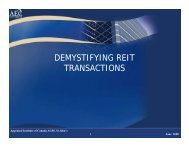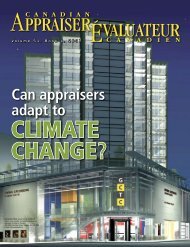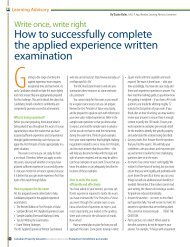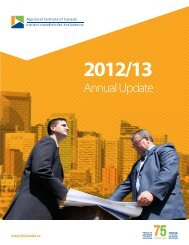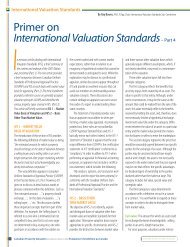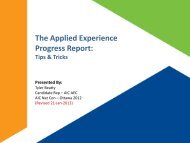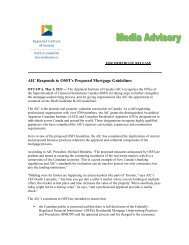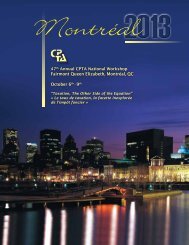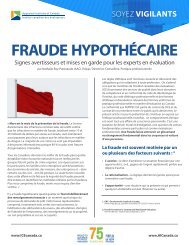Extended article â Ground Leases - Appraisal Institute of Canada
Extended article â Ground Leases - Appraisal Institute of Canada
Extended article â Ground Leases - Appraisal Institute of Canada
Create successful ePaper yourself
Turn your PDF publications into a flip-book with our unique Google optimized e-Paper software.
“Sufficient market demand is aprecursor <strong>of</strong> highest and best useanalysis in the context <strong>of</strong> financialfeasibility <strong>of</strong> a particular use andscale <strong>of</strong> development that has passedthe initial tests <strong>of</strong> legal permissibilityand physical possibility.”discretion <strong>of</strong> the tenant at the time <strong>of</strong> the rent review, may cause some or all<strong>of</strong> the uses permitted under the prevailing land use controls or those strictlydictated by the lease to be financially infeasible for ground-up development.This results in rental payments lower than those achievable, based on anunrestricted highest and best use analysis. In this sense, a ground lease issimilar to a space lease, whose length <strong>of</strong> occupancy available to the tenantis determined by the term <strong>of</strong> the lease. In defining a ground lease valuationproblem in the context <strong>of</strong> highest and best use, the most critical andinterrelated issues confronting the appraiser are as follows:• the identification <strong>of</strong> what is to be appraised (i.e., land only or landand improvements), based on a thorough reading <strong>of</strong> the lease or asinstructed by legal counsel;• the constraints <strong>of</strong> the lease, if any, imposed on highest and best useanalysis, to determine whether the valuation is <strong>of</strong> the fee simple interestor <strong>of</strong> the estate for years, 9 reflecting the period remaining on thelease at the time <strong>of</strong> the rent review;• the legally permissible use(s) governed by the prevailing land usecontrols or the use(s) dictated by the language <strong>of</strong> the lease;• the scale <strong>of</strong> development legally permissible pursuant to the provisions<strong>of</strong> the prevailing land use controls or the scale <strong>of</strong> development dictatedby the language <strong>of</strong> the lease;• the physical constraints <strong>of</strong> the land, if any, imposed on the scale <strong>of</strong> developmenteither legally permissible or dictated by the language <strong>of</strong> the lease;• the remaining term <strong>of</strong> the lease, including any renewal options exercisableat the discretion <strong>of</strong> the lessee; and• the marketability and financial feasibility <strong>of</strong> the legally permissibleuse(s) or the use(s) dictated by the language <strong>of</strong> the lease, and achievablein the context <strong>of</strong> the remaining term <strong>of</strong> the lease, including anyrenewal options available to the lessee.Market analysisThrough supply and demand analysis, the appraiser identifies and tests thelevel <strong>of</strong> market support for legally permissible and physically possible uses,while recognizing any restrictions or constraints imposed by the lease. Sufficientmarket demand is a precursor <strong>of</strong> highest and best use analysis in thecontext <strong>of</strong> financial feasibility <strong>of</strong> a particular use and scale <strong>of</strong> developmentthat has passed the initial tests <strong>of</strong> legal permissibility and physical possibility.For example, in Michelson, 10 insufficient demand for <strong>of</strong>fice space renderedthe hypothetical development <strong>of</strong> an <strong>of</strong>fice tower on the leased landunfeasible at the date <strong>of</strong> the rent review, reinforcing the critical role <strong>of</strong> supplyand demand in highest and best use analysis. The ground lease was for aterm <strong>of</strong> 55 years, with the rent scheduled to be reset initially at the end <strong>of</strong>the 25th year <strong>of</strong> the lease term. The lease provided as follows:Upon the expiration <strong>of</strong> the twenty-fifth (25th) year ... <strong>of</strong> the term <strong>of</strong> thislease, the basic rental shall be adjusted to that sum which the lessor couldderive from said property if it were made available on the open market for newleasing purposes for ... [<strong>of</strong>fice] use (exclusive <strong>of</strong> the value <strong>of</strong> lessee’s improvementsthereon);On the date <strong>of</strong> the first rent review, the remainder <strong>of</strong> the initial lease termwas 30 years, with the parties reaching consensus on the following issues:The parties agree the lease requires the rent adjustment, ‘if any,’ to bedecided on the basis <strong>of</strong> a valuation <strong>of</strong> a hypothetical transaction. ... First, itmust be imagined the improvements to the property do not exist, becausethe rent for the property must be determined ‘exclusive <strong>of</strong> the value <strong>of</strong> lessee’simprovements thereon.’ Second, the relevant question is the market valuation<strong>of</strong> a new 55-year ground lease in 2002, with the same terms and conditionsas those contained in the original ground lease (other than an adjustment <strong>of</strong>dates). This interpretation follows from the lease’s directive to adjust the rentbased on making the property available ‘on the open market for new leasingpurposes....’ Neither party contends the lease demands a valuation <strong>of</strong> a 30-yearground lease (the remainder <strong>of</strong> the actual term), which would presumablyreduce the value <strong>of</strong> the leasehold. The parties stipulate that the only permitteduse <strong>of</strong> the property in 2002 was for an <strong>of</strong>fice building similar in size to thebuilding actually in existence.The rent adjustment clause called for an estimate <strong>of</strong> basic rent, but as noprovision in the lease instructed the appraisers to assume a 55-year term,application <strong>of</strong> land residual analysis should have reflected an economic life<strong>of</strong> 30 years for the hypothetical leasehold improvements, consistent with theremaining term <strong>of</strong> the lease. The court considered what was the appropriatevaluation methodology and what assumptions were appropriate in applyingthat methodology to the ground lease at issue.In Michelson, the landowner’s appraiser relied on a land residual analysisas a check against the freehold land value estimate derived from the salescomparison approach. The lessee’s appraiser relied on land residual analysissolely to demonstrate a lack <strong>of</strong> financial feasibility stemming from a lack <strong>of</strong>demand for <strong>of</strong>fice space, a position supported by an absence <strong>of</strong> any new<strong>of</strong>fice development and an extremely high <strong>of</strong>fice vacancy rate in the localmarket. The appeals court upheld the trial court’s ruling that no increase inbasic rent was warranted:We agree with Michelson that ... [its appraiser’s] approach measuresthe economic feasibility <strong>of</strong> the ground lease transaction proposed in the rentadjustment provision. We further agree that the court was entitled to rely ona measurement <strong>of</strong> economic feasibility as a prerequisite to the assumption
that a ground lease transaction would actually be consummated on the ‘openmarket.’… [I]n the statement <strong>of</strong> facts, the cap rate used by the experts incalculating the feasibility <strong>of</strong> a ground lease at the property is issue determinative....The lease calls for an upward adjustment <strong>of</strong> rent if the rent that could bederived exceeds $88,165. Using [the landowner’s appraiser’s] cost ($13,497,000)and NOI (ignoring ground rent, $1,525,838) assumptions, the margin forpaying ground rent gradually evaporates upon increases in the assumed [building]cap rate:Cap Rate (R B)Feasibility Income to SupportResidual Construction Costs<strong>Ground</strong> Rent8.25% $1,113,502 $412,3369% $1,214,730 $311,1089.70% $1,309,209 $216,62910% $1,349,700 $176,13811% $1,484,670 $41,16815% $2,024,550 -$498,712[The lessee’s appraiser’s] methodology does not directly determine market rent;it determines whether sufficient income would be generated to make the dealrational for both the ground lessor and ground lessee.END NOTES (Part 1)1Black’s Law Dictionary, Centennial Ed. (1891–1991), 6th ed., 704.2International Valuation Standards (IVS) Glossary, in <strong>Appraisal</strong> <strong>Institute</strong>,Dictionary <strong>of</strong> Real Estate <strong>Appraisal</strong>, 5th ed. (Chicago: <strong>Appraisal</strong> <strong>Institute</strong>,2010), 249.3Dictionary <strong>of</strong> Real Estate <strong>Appraisal</strong>, 92.4In <strong>Canada</strong>, the Central Mortgage and Housing Corporation (CMHC) considersa 60-year land lease intended to accommodate residential use asbeing equivalent to 75% <strong>of</strong> the value <strong>of</strong> outright ownership. See, http://www.cmhc-schl.gc.ca/en/inpr/afhoce/tore/afhoid/fite/lale/lale_001.cfm. Research conducted by Capozza and Sick indicated that 80-year to90-year prepaid land leases with single-family dwellings in the SalishPark area <strong>of</strong> the City <strong>of</strong> Vancouver, <strong>Canada</strong>, sold for a 20% to 40%discount from comparable fee-simple properties in the adjacent Dunbarand Kerrisdale areas. See “Valuing Long-Term <strong>Leases</strong>: The Option toRedevelop,” Journal <strong>of</strong> Real Estate Finance and Economics 4 (1991): 209.5Basingstoke and Deane Borough Council v. Host Group Ltd., [1988] 1 WLR348, 56 P&CR 31, 284 EG.6In McDonalds Real Estate Ltd Liability Partnership v. Arundel Corporation,[2008] 2 EGLR 53, [2008] EWHC 377 (Ch), McDonalds entered intoa 50-year ground lease for a 1.3-acre site in 1985 for the purpose <strong>of</strong>developing its first drive-thru restaurant in the UK. The lease contains covenantsto comply with the Planning Acts and to use the demised premisesonly as a restaurant, together with ancillary <strong>of</strong>fice accommodation,storage, staff facilities, and car-parking space in connection therewith, orfor such other retail uses the landlord might authorize, such authority notto be unreasonably withheld or delayed. The rent is to be reset at five-yearintervals throughout the term <strong>of</strong> the lease on the understanding thatthe second method <strong>of</strong> estimating market rent at each rent review is toassume a term <strong>of</strong> 20 years, regardless <strong>of</strong> the actual remaining term, andis to apply to both the land and a hypothetical “modern single-storeywarehouse comprising 20,000 net useable square feet <strong>of</strong> which 15%were useable as ancillary <strong>of</strong>fices and constructed to a high standard inaccordance with all statutory and other relevant consents with all usualamenities, including adequate parking and loading facilities.”7Whether highest and best use analysis <strong>of</strong> land is undertaken on anunrestricted or restricted basis, the highest and best use must still belegally permissible, physically possible, financially feasible, and maximallyproductive. <strong>Appraisal</strong> <strong>Institute</strong>, The <strong>Appraisal</strong> <strong>of</strong> Real Estate, 13thed. (Chicago: <strong>Appraisal</strong> <strong>Institute</strong>, 2008), 278–279.8This is analogous to valuing a property as if vacant, unimproved, andunencumbered, and, in the absence <strong>of</strong> a jurisdictional exception, mayrequire the appraiser to impose a hypothetical condition on the highestand best use analysis.9Also known as a ‘tenancy for years,’ and defined as “a leasehold interestin real estate established by a contract for possession for a specifiedperiod <strong>of</strong> time.” The Dictionary <strong>of</strong> Real Estate <strong>Appraisal</strong>, 195.102151 Michelson, L.P., v. Corp. <strong>of</strong> The Presiding Bishop <strong>of</strong> The Church <strong>of</strong> JesusChrist <strong>of</strong> Latter-Day Saints, G039654, 2008 Cal. App. Unpub. LEXIS 10002.WEB CONNECTIONSThe following Internet resources are suggested by the Y. T. and Louise LeeLum Library:• National Association <strong>of</strong> Realtors, Field Guide to <strong>Ground</strong> <strong>Leases</strong>http://www.realtor.org/library/library/fg410• National Retail Properties Net Lease Exchange http://www.nnnex.com/• NCREIF—database with valuation/lease data and transaction datahttp://www.ncreif.org/data.aspx• Society <strong>of</strong> Industrial and Office Realtors http://www.sior.com
<strong>Ground</strong> leases:rent reset valuation issues (PART 2)Testing the legalpermissibility <strong>of</strong> land as though vacantIn applying the test <strong>of</strong> legal permissibility, the appraiser determines whichuses are permitted by current zoning, which uses could be permitted ifa zoning change were granted, and which uses are restricted by privaterestrictions on the site. Private restrictions, deed restrictions, and long-termleases may prohibit certain uses or specify building setbacks, heights, andtypes <strong>of</strong> materials. If deed restrictions conflict with zoning laws or buildingcodes, the more restrictive guidelines usually prevail. A long-term lease mayaffect the highest and best use because lease provisions may limit use overthe remaining term <strong>of</strong> the lease.Testing the financialfeasibility <strong>of</strong> land as though vacantOnly those uses whose value is commensurate with cost, and which arelegally permissible and physically possible, are considered financially feasible.For income properties, the analysis focuses on potential uses that arelikely to produce an income (or return) equal to or greater than the amountneeded to cover operating expenses, financial obligations, and capital amortization<strong>of</strong> the investments. Any external obsolescence related to a specificuse should be incorporated into the test <strong>of</strong> financial feasibility.Timing for a specific use is a function <strong>of</strong> supply and demand, and refers towhen improvements should be built in conjunction with future expectations<strong>of</strong> occupancy and rent levels. Land and location favour financially feasible useswith near-term development potential, as near-term development land is morevaluable today due to the time-value <strong>of</strong> money and the risk pr<strong>of</strong>ile.Financeability <strong>of</strong> leasehold improvementsAppraisers <strong>of</strong>ten overlook or underestimate issues associated with thefinanceability <strong>of</strong> leasehold improvements in ascertaining financial feasibilityas part <strong>of</strong> highest and best use analysis. A ground lease has priority overa leasehold mortgage unless the lease has been subordinated in favour <strong>of</strong>the leasehold mortgagee. As a general rule, leasehold financing is morecostly than financing a fee simple interest. Some <strong>of</strong> the issues that should beconsidered in addressing financeability <strong>of</strong> leasehold improvements and theimpact on highest and best use analysis are:• the ground lease itself as an encumbrance against the property, andwhether the lease is assignable and mortgageable; 11• the use(s) permitted by the ground lease (a narrow range <strong>of</strong> permitteduses will appeal less to a mortgage lender, and vice versa);• the term remaining on the ground lease at the time <strong>of</strong> the rent review(a short remaining term will appeal less to a mortgage lender, and viceversa); 12• the frequency <strong>of</strong> rent resets during the remaining term <strong>of</strong> the groundlease (more frequent rent resets will appeal less to a mortgage lender, andvice versa);• the required or anticipated method <strong>of</strong> rent adjustment;• the right <strong>of</strong> the mortgagee to cure any default by the lessee <strong>of</strong> the provisions<strong>of</strong> the ground lease;• the right to reconstruct damaged leasehold improvements; and• the lease provisions, if any, that provide mortgagee protections.In the context <strong>of</strong> land assumed to be unimproved, those uses found to befinancially feasible are tested to ascertain the comparative productivity <strong>of</strong>each use and to determine which use produces the maximum productivity.Different uses have different risk pr<strong>of</strong>iles, and market participants demandvarying rates <strong>of</strong> return at different points in time. 13 Of the financially feasibleuses tested, the highest and best use is the use that produces the highestresidual land value, consistent with the market’s perception <strong>of</strong> risk and therate <strong>of</strong> return demanded by the market for the perceived risk associated withthe use.Absent any legislative or public policy constraints, determining financialfeasibility is a collaborative effort between landowner and lessee, witheach party wanting to maximize its financial position by working to reacha consensus as to the most productive use(s) to be made <strong>of</strong> the land withinthe term <strong>of</strong> the ground lease. When the rent is to be reset during the term<strong>of</strong> the lease, the initial use(s) and scale <strong>of</strong> development may no longer befinancially feasible because <strong>of</strong> changes in market conditions and limitationsimposed by the language and remaining term <strong>of</strong> the lease. A use predeterminedor dictated by the language <strong>of</strong> a lease may not be financially feasibleat the time <strong>of</strong> rent review, which can negatively impact the earning potential<strong>of</strong> the land. 14Distinguishing betweenmarket value and market rentMarket value concerns itself with vendors and purchasers, whereas marketrent only pertains to lessors and lessees, a distinction articulated in Bondiv. City <strong>of</strong> Toronto. 15 In that case, the appeals court rejected the appraiser’sestimate <strong>of</strong> rent and the two-step methodology <strong>of</strong> estimating rent based onthe unrealizable value <strong>of</strong> the land in its (unrestricted) highest and best use.[The appraiser founded his] opinion as to the present sale value <strong>of</strong> the land
viewed from the angle <strong>of</strong> its redevelopment potentiality. Even assuming that thiswas a perfectly proper manner <strong>of</strong> fixing the value <strong>of</strong> the freehold to the ownerthere<strong>of</strong> who would eventually realize that potentiality, there was a completeabsence <strong>of</strong> evidence as to what part, if any, <strong>of</strong> that potentiality would be realizedduring the 21-year period <strong>of</strong> the lease for which the rent was to be fixed.In the rental dispute between B.C. Rail Partnership (lessor) and PacificWest Systems Supply Ltd. (lessee), 16 the ground lease was for a term <strong>of</strong> 20years and included a provision for reviewing the rent at five-year intervals.The rent was to be adjusted in accordance with a clause stating “the revisedrental shall reflect a fair market rental on the date <strong>of</strong> such adjustment.”The appeals court noted the lease called only for an estimate <strong>of</strong> fair marketrental, and that objective differed from the language <strong>of</strong> the rent reviewclauses <strong>of</strong> the ground leases in the two other cited cases 17 that had dictateda two-step approach to estimating renewal rent. In the two cases cited, theprimary objective was to estimate land value as bare land, to which wasapplied the rate <strong>of</strong> return specified in the lease in fixing the new annual rent.A similar distinction was drawn between market rental value and marketvalue in Bullocks’ Inc. v. Security-First National Bank <strong>of</strong> Los Angeles: 18Rental value is measured partially in terms <strong>of</strong> time, by the month or by theyear, et cetera. The parties were not fixing rental value in the lease, they werefixing rent. They determined such rent by taking a ... fixed percentage <strong>of</strong> the fullvalue (not the rental value) <strong>of</strong> the land. The parties based rent upon the fairmarket value <strong>of</strong> the property rather than upon its rental value for any givenperiod <strong>of</strong> time.Valuation premiseContested rent reset clauses accompanied by a lack <strong>of</strong> appropriately definedor described terms can lead to widely divergent conclusions as to the interestto be appraised (freehold or remaining lease term), 19 the nature <strong>of</strong> thedemised premises (land or land and improvements), and the highest andbest use. Courts in common law jurisdictions have consistently held that thelease itself, as an encumbrance, 20 is a restriction on the use <strong>of</strong> land that must betaken into account in fixing the rent unless the lease contains language to theeffect that the lease is to be ignored. 21 The following cases illustrate this point.In New York Overnight Partners v. Gordon, 22 the rent for the 15-yearrenewal term <strong>of</strong> the lease was to be calculated at 6.5% <strong>of</strong> the ‘appraisedvalue <strong>of</strong> the land.’ The lease expressly excluded from the definition <strong>of</strong> ‘land’the ‘buildings and improvements thereon erected.’ When the parties failedto reach consensus on the meaning <strong>of</strong> the phrase ‘appraised value <strong>of</strong> theland,’ they sought judicial interpretation to settle the dispute. The appealscourt upheld the lower court’s findings that, “the appraiser must determinethe value <strong>of</strong> the land as though vacant, without improvements,” because thelease expressly provided that the appraiser value the land as unimproved.Pursuant to the express terms <strong>of</strong> the ground lease, the parties did not intendthe land to be appraised for its highest and best use as currently improved toestablish the rental rate for the renewal term. 23In Ruth E. Abers et al., v. Christine Marie Rounsavell, 24 the rent for theleased land was to be reassessed after 30 years, adjusted to 8% <strong>of</strong> the thencurrent fair market value, exclusive <strong>of</strong> all land improvements. The disputefocused on the meaning <strong>of</strong> ‘leased land’ as used in 150 single-unit leasescreated on an 18.5-acre parcel developed as a leasehold condominium project.In 1969, the landowner initially entered into a 55-year unitary groundlease with a developer to lease 18.5 acres for development as apartments. In1974, the ground lease was amended and conveyed to another developer fora term <strong>of</strong> 75 years to accommodate a phased 150-unit condominium project,with the ground lease converted to 150 individual leases. As the unitswere sold, each purchaser signed an assignment for the particular describedcondominium. The assignment contained the same legal description <strong>of</strong> theleased property as the ground lease to which it pertained. In May 1975,with the division <strong>of</strong> the ground lease into separate condominium leases,the landowner and developer formally cancelled the ground lease. ‘Leasedland’ was defined as a specified condominium unit along with an undividedinterest in the common area in each <strong>of</strong> the two leasehold condominiumparcels. In addressing the meaning <strong>of</strong> leased land, the trial court concludedleased land meant “the entire 18 and one-half acre parcel <strong>of</strong> land on whichthe condominium complex was located” and that “the 18 and one-half acreparcel would be assessed at its ‘highest and best use.’” In overturning thelower court’s ruling, the appeals court observed:The plain language in the recorded deeds gives rise to the reasonablyjustified expectation that the rent adjustment clauses will be limited to the fairmarket value <strong>of</strong> the leaseholds for the [150] individual condominium units,rather than fair market value <strong>of</strong> the entire 18 and one-half acres.In 853 Seventh Ave. Owners, 25 the court examined the term ‘demisedpremises’ in lease provisions. The court commented as follows:In [the opinion <strong>of</strong> the Court <strong>of</strong> Appeals in 936 Second Ave. L.P. v. SecondCorporate Dev. Co., Inc. ...], where the determination <strong>of</strong> rent for the net leasewas to be based on ‘the value <strong>of</strong> the demised premises with all buildings andimprovements thereon, including any and all improvements erected by tenant,’... the Court found that the net lease itself was to be taken into account indetermining the rent.... Since the wording <strong>of</strong> the lease here at issue specificallyexcludes buildings or improvements, as well as the lease itself, from thedetermination <strong>of</strong> value, the finding in 936 Second Ave. is <strong>of</strong> no effect.In Revenue Properties v. Victoria University, 26 the arbitrators fixed therenewal rent for the demised premises both as unencumbered and encumberedby the lease, leaving the court to interpret the rent reset clause. Thelease did not indicate that the lands were to be considered as if unencumbered;therefore, the court ruled that the valuation had to take into accountthe lease as an encumbrance against the lands. According to the court, to dootherwise, “would be to ignore the very basis <strong>of</strong> the relationship betweenthe parties as a landlord and tenant and would create a highly artificial situation.”The court went on to note “the entire arbitration is because there is alease. Therefore it is necessary to acknowledge that the lands are subject to alease even without considering the specific details <strong>of</strong> the lease.”In City <strong>of</strong> Vancouver v. David William Martin et al., 27 the arbitratorsreached a similar conclusion and recognized the lease itself as an encumbranceby drawing a distinction between unencumbered fee simple value
and “market rental value <strong>of</strong> the said lands,” 28 stating that “the direction inthe model lease is to determine the market rental value.” In reaching thisconclusion, the arbitrators relied upon the following two cases:• No. 100 Sail View Ventures Ltd. v. Janwest Equities Ltd., 29 where the courtconsidered a rent review provision that required that the new rent be“10% <strong>of</strong> the fair market value <strong>of</strong> the leased premises as bare land at thedate <strong>of</strong> the review.” The issue was whether this language required thatuse restrictions in the lease be taken into account when arriving at the“fair market value <strong>of</strong> the leased premises as bare land.” The finding <strong>of</strong>the majority <strong>of</strong> the court was that the phrase “fair market value <strong>of</strong> theleased premises as bare land” meant that the valuation had to be donewithout reference to the lease and consequently without reference to therestricted use found in the lease. 30• In Pacific West Systems Supply Ltd. v. B.C. Rail Partnership, 31 the court <strong>of</strong>appeals considered whether the use restrictions in the lease should betaken into account when a rent review provision required a determination<strong>of</strong> ‘fair market rental.’ As in No. 100 Sail View, the review provision stipulatedthat improvements created by the tenant were to be disregarded.The landlord argued that as the improvements were to be disregarded, itfollowed that the use restrictions in the lease also should be disregarded.The court disagreed, and distinguished this case from No. 100 Sail View onthe basis that, in that case, the lease called for a determination <strong>of</strong> ‘the fairmarket value,’ whereas the lease in Pacific West required a determination<strong>of</strong> ‘market rental.’ The court found that, to determine market rental, “theterms <strong>of</strong> the lease the tenant holds are critical,” and that there was “nosound basis on which it can be said that the parties to this lease can haveintended that the tenant be put in the position <strong>of</strong> paying rent based onthe unrestricted use <strong>of</strong> the lands when it is precluded from enjoying whatmay be the highest and best use.” 32In Manhattan Church <strong>of</strong> Christ Inc. v. 40 East 80 Apt. Corp., a lease provisionexplicitly excluded the lease, as well as the improvements, from considerationin estimating the “fair market value” <strong>of</strong> the land. The lease stated,“The basic rent ... during each 20-year period ... shall be an amount perannum equal to 6% <strong>of</strong> the fair market value ... <strong>of</strong> the land ... considered asvacant, unimproved and unaffected by this lease.... 33 Conversely, in PlazaHotel Assocs. v. Wellington Assoc., 34 the rent reset clause did not contain thelanguage ‘unaffected by this lease,’ and, therefore, the court considered thelease restriction regarding the use <strong>of</strong> the property, as it caused the propertynot to be put to its (unrestricted) highest and best use.A more recent decision, Basingstoke and Deane Borough Council v. HostGroup Ltd., 35 also held that, if a rent review clause makes no provision toignore the lease itself, all <strong>of</strong> the subsisting terms and conditions <strong>of</strong> the leasemust be taken into account in estimating ground rent. The ruling makes nodistinction between land leases and land and building leases. Arguing infavour <strong>of</strong> a presumption founded on the reality <strong>of</strong> the entire ground lease,the appeals court articulated its position as follows:The declaration ... made by the judge was that the valuer should assess theup-to-date rental value on the basis that the demised premises were availablefor letting on the terms and conditions <strong>of</strong> a hypothetical lease containing ‘suchterms and conditions as the valuer regards as reasonable for a lease <strong>of</strong> a baresite for development current at the relevant date’ and that the site is availablefor any lawful use. This construction <strong>of</strong> para (vii) [the rent review clause] wouldmean that the valuer’s role would not be confined ... to assessing the value <strong>of</strong>a property with stated characteristics. His role would extend to choosing some<strong>of</strong> the characteristics <strong>of</strong> the property ... namely ‘such terms and conditions asthe valuer regards as reasonable for a lease <strong>of</strong> a bare site at the relevant date.’Paragraph (vii) contains no express direction giving such a power to the valuer.... The natural (and, indeed necessary) implication from the terms <strong>of</strong> para(vii), read as a whole in its context in this lease, is that the rental value to beassessed by the valuer is <strong>of</strong> a notional letting on the same terms (other than asto quantum <strong>of</strong> rent) as those subsisting between the actual parties to the leasebut modified to the extent expressly provided....Remaining term <strong>of</strong> leaseThe term remaining on the lease, plus any term extension provided by way<strong>of</strong> a renewal option exercisable at the discretion <strong>of</strong> the lessee, is an importantconsideration in determining the highest and best use <strong>of</strong> a property.Highest and best use analysis is not only concerned about the timing <strong>of</strong> aparticular use and scale <strong>of</strong> development, but it is also sensitive to the length<strong>of</strong> time required to fully amortize the investment in a particular developmentby providing the lessee with both a return on and return <strong>of</strong> the investmentand ensuring third-party mortgage financing can be obtained for leaseholdimprovements.When development costs required to support a particular use and scale<strong>of</strong> development cannot be financed and/or recovered by the lessee (developer)over the remaining term <strong>of</strong> a ground lease, including any renewaloption, that particular use is precluded from consideration as a candidatefor highest and best use. Highest and best use analysis is forward-lookingfrom the date the rent is to be reset rather than from the date the lease wasinitially executed, regardless <strong>of</strong> whether the lease itself is to be ignored.The term remaining coupled with any extension <strong>of</strong> the term available to thelessee are taken into consideration in reaching a conclusion as to highestand best use over the investment horizon. This means that the amount <strong>of</strong>potential rent flowing from a particular use is dependent on the term <strong>of</strong> thelease remaining at the date <strong>of</strong> rent review.In United Equities v. Mandordic, 36 the court, in a split decision, concludedthat the value <strong>of</strong> the land should be appraised according to its highest andbest use, and not as only a garage. The court said, however, that considerationwould have to be given to the term <strong>of</strong> the lease and the renewal optionin determining the use to which the land could be put. Weis characterizesthis court decision as follows. 37Presumably, the intent <strong>of</strong> the majority opinion was to instruct theappraiser: Go ahead and appraise the property for its highest and best use. Butbear in mind that the lease has 21 years to go, with one more renewal optionfor 21 years. When you value the land for its highest economic use, rememberthat you only have the right to use the land for a maximum period <strong>of</strong> 42 years.
If you project a higher use for the land, limit your appraisal to that stipulatedperiod <strong>of</strong> time. This might influence your maximum value. Ask yourself, “Howmuch would a builder or any other user <strong>of</strong> the land pay for it, faced with thistime limitation [42 years]?”As a practical matter, a lessee can only control a property for the term<strong>of</strong> the lease, including any extensions <strong>of</strong> the lease. Depending on how longthe lessee can potentially maintain control <strong>of</strong> the property, reconstructing orreplacing existing improvements to accommodate another use or the sameuse at a higher density in response to changing market conditions may not befinancially feasible or allowed by the lease.In highest and best use analysis, the level <strong>of</strong> rent flowing from a particularuse is also impacted by the remaining term <strong>of</strong> the lease at the date <strong>of</strong> therent review, as noted in the following two cases.In Wu et al. v. Interstate Consolidated Industries et al., 38 the tenants <strong>of</strong> amotion picture theater exercised the second <strong>of</strong> three five-year options from1986 to 1991. When the parties failed to reach agreement, three appraiserswere appointed to determine the fair market rental value. On the basis <strong>of</strong> thepotential highest and best use <strong>of</strong> the premises as retail shops, rent reflectingthe average <strong>of</strong> the two closest appraisals was fixed at $8,475 per month.Another appraisal by one <strong>of</strong> the two appraisers, along with the appraisal<strong>of</strong> the third appraiser, reflected an average rent <strong>of</strong> $3,083 per month, if thepremises continued to be used as a theater. The lease restricted use <strong>of</strong> thepremises to a theater, and the appeals court found that the purpose <strong>of</strong> arenewal option clause was to benefit the financial interests <strong>of</strong> the tenant byensuring an opportunity to continue its business and recoup its investment.The court stated, “An interpretation that the rent during the option terms is tobe based upon the highest and best use <strong>of</strong> the property despite the purposesfor which lessor and lessee agreed it could be used, would be economicallyunreasonable and violate the intent <strong>of</strong> the parties.” The appeals court furtherexpressed concern over the prospect <strong>of</strong> an ever-changing highest and bestuse that the tenant could never exploit during the five-year period betweeneach rent review:ICI contends that, to remain in the premises, Wu must incur the substantialexpense <strong>of</strong> converting the theater into a retail shopping centre, an investmentWu may never recoup because, in another five years, ICI may conclude there isyet another highest and best use <strong>of</strong> the property.... Such an option is, in essence,no option, is unreasonable, and could not have been the intent <strong>of</strong> the partieswhen they signed the lease.Chancebutton Limited et al. v. Compass Services UK & Ireland Limited 39 addressesthe issue <strong>of</strong> whether an estimate <strong>of</strong> market rent at the rent review date should bebased on the original term <strong>of</strong> a lease or the remaining term <strong>of</strong> a lease. The lesseecontended that the term reflected the remaining term <strong>of</strong> five years at the date<strong>of</strong> the rent review, while the landlord contended that the hypothetical term was25 years commencing on the relevant review date. In siding with the lessee, thecourt observed that, “The courts have consistently construed rent review clausesrequiring that the hypothetical term be ‘equal to’ or ‘equivalent to’ the term <strong>of</strong> theactual lease as requiring that the rent be determined on the assumption that onlythe unexpired residue <strong>of</strong> the original term remains.” 40Change in zoningA ground lease that is written to take into consideration any changes inzoning effected after the commencement <strong>of</strong> the lease can work to thebenefit <strong>of</strong> either the landowner or the lessee when it comes time to reassessthe rent, as noted in examples in Commentary on Form <strong>of</strong> <strong>Ground</strong> Lease: 41Example 1In Ruth, 42 the tenant, who leased property next to the Third Avenue elevatedrailroad, was required to build a two-storey building and to maintain thebuilding in good condition. The tenant could not substantially alter thebuilding without the landlord’s consent. At the time that the new rent(6% <strong>of</strong> the ‘full and fair value <strong>of</strong> the land ... vacant and unimproved, in feesimple, ... free <strong>of</strong> lease and unencumbered....’) was to be determined, theelevated railroad had been demolished, and much larger buildings could beconstructed because <strong>of</strong> zoning changes. Accordingly, the value <strong>of</strong> the land, aslimited by the lease restriction requiring the tenant to maintain a two-storeybuilding, was considerably less than the value <strong>of</strong> the land unencumbered bythe lease. The court determined that the valuation must be made withoutany consideration <strong>of</strong> the use restrictions contained in the lease because thelease expressly provided that the land was to be valued as if unencumberedby the lease. The rent was reset at a level that the lessee could not afford topay, and the lessee defaulted on the ground lease and forfeited the improvements.Example 2In New York Overnight Partners, L.P., 43 a ground lease provision called fora determination <strong>of</strong> the ‘appraised value <strong>of</strong> the land.’ The property had beenzoned downward after the execution <strong>of</strong> the lease, in that the existing building,although a legal non-conforming use, was larger than could have beenconstructed under current zoning laws. The lease defined ‘land’ to specificallyexclude improvements. The court held that the appraiser must determine thevalue <strong>of</strong> the land as though vacant, without improvements. The court alsostated that although land value should ordinarily be appraised at its highestand best use, the fair market value must be determined with reference toany existing restrictions on the land, including the term <strong>of</strong> the lease andcurrent zoning regulations. The court emphasized that because this leaseclearly indicated that the value was to be determined as if the property wasraw, vacant land, the beneficial impact on the value <strong>of</strong> the property <strong>of</strong> theexisting nonconforming use could not be considered....<strong>Appraisal</strong> proceduresAppraisers should apply valuation procedures that are consistent with theoverall objective <strong>of</strong> the rent review clause or as specifically directed by thelanguage <strong>of</strong> the lease. 44 A combination <strong>of</strong> valuation inputs and proceduresmay be required, depending on the language <strong>of</strong> the rent review clause,the particular opinion <strong>of</strong> value being sought, and the quantity and quality<strong>of</strong> market data available. The selection <strong>of</strong> necessary valuation inputs mayinclude, but are not limited to, the following items:• land sales and land leases;• investor surveys;
• land and land and building rates <strong>of</strong> return;• availability <strong>of</strong> mortgage financing;• leasing commissions;• appropriate units <strong>of</strong> comparison (floor area ratio, net rentable area, etc.); 45• space/unit inventory and absorption;• land rents and building space rents;• operating costs;• construction costs;• mortgage financing costs;• tenant inducements;• appropriate measurement standards; and• consumer price index or other indices.Appraisers enjoy broad discretion in deciding which factors are relevant toa particular valuation problem and how such factors impact the valuation,absent an agreement expressly requiring or precluding consideration <strong>of</strong>such factors. 46 While market value and market rent are well-defined by theappraisal pr<strong>of</strong>ession, other types <strong>of</strong> value, not as clearly defined or describedin a lease may require interpretation by the court.ConclusionRent reset assignments can present appraisers with some <strong>of</strong> the mostchallenging and complex valuation work. However, as with every appraisalassignment, problem identification is the first step, and that necessitates athorough reading <strong>of</strong> the ground lease. In common law jurisdictions, therehas been a stream <strong>of</strong> precedents that makes no distinction between landand building leases and land leases in recognizing the subsisting terms <strong>of</strong> alease, including the remaining term, premised on a presumption <strong>of</strong> realitywhen dealing with rent reset clauses. Of course, the parties to a lease arefree to override a presumption <strong>of</strong> reality by including lease language to thecontrary. 47Highest and best use analysis, whether undertaken on an unrestrictedor restricted basis, pursuant to the language <strong>of</strong> a lease, must considersupply and demand as part <strong>of</strong> the test <strong>of</strong> financial feasibility, which includesissues <strong>of</strong> mortgage financeability. The selection <strong>of</strong> appraisal procedures tobe applied and the factors to be considered will depend entirely upon theopinion <strong>of</strong> value sought, whether market value, market rent, or some otherdefined or described opinion <strong>of</strong> value, pursuant to the rent review provisions<strong>of</strong> the lease. In those instances where the direction or meaning <strong>of</strong> the rentreview clause is unclear, the courts may have to intervene and provide thenecessary guidance.End notes (Part II)11Airport Plaza, Inc. v. Gladys Motley Blanchard, 188 Cal. App. 3d 1594; 234Cal. Rptr. 198; 1987 Cal. App. LEXIS 1346. In denying Airport’s request tomortgage its leasehold estate and dissolve the corporation and assign itsassets, including the ground lease, to its two shareholders, the appealscourt found that hypothecation constitutes an assignment <strong>of</strong> less thanthe entire leasehold, which is prohibited by the ground lease without theconsent <strong>of</strong> the landowner. The court further found that no commerciallender would make a loan without requiring the landowner to consent toconditions, which would amount to an amendment <strong>of</strong> the ground lease.The court also found that the lessee was entitled to assign the entireleasehold estate without the landowner’s consent, but only if the assignorremained personally liable on the ground lease.12The City <strong>of</strong> Vancouver was compelled to extend all <strong>of</strong> its existing 40- and41-year ground leases, thereby enabling cash-starved housing co-operativesto obtain leasehold mortgage financing to cover the high cost <strong>of</strong>building envelope failure associated with many housing projects. HousingPolicy Report, Vancouver City Council, February 16, 2005, CC File No.: 4664.13Investors will accept different rates <strong>of</strong> return, depending on investmentalternatives and differing levels <strong>of</strong> risks inherent in the use, location, andother characteristics <strong>of</strong> the property.142151 Michelson, L.P. v. Corp. <strong>of</strong> The Presiding Bishop <strong>of</strong> The Church <strong>of</strong> JesusChrist <strong>of</strong> Latter-Day Saints.15In Bondi v. City <strong>of</strong> Toronto, [1967] O.J. No. 1112, the land was leased for 21years, with the lessor granting the lessee a further 21 years at an agreedupon rent to be “at such rent per foot frontage per annum as the saiddemised premises shall be worth irrespective <strong>of</strong> any improvements madethereon by the lessee or any prior lessee there<strong>of</strong>.”16Pacific West Systems Supply Ltd. v. B.C. Rail Partnership, 2003 BCSC 391,2004, BCCA247 (Can LII).17No. 100 Sail View Ventures Ltd. v. Janwest Equities Ltd., (B.C.C.A.) [1993]B.C.J. No. 2338. (Leave to appeal to the Supreme Court <strong>of</strong> <strong>Canada</strong> denied.)and Musqueam Indian Band v. Glass, 2000 SCC 52, [2000] 2 S.C.R. 633.18Bullock’s Inc. v. Security-First National Bank <strong>of</strong> Los Angeles, 160 Cal. App. 2d277; 325 P.2d 185; 1958 Cal. App. LEXIS 2119.19David C. Lennh<strong>of</strong>f, “You Can’t Get the Value Right if You Get the RightsWrong,” The <strong>Appraisal</strong> Journal (Winter 2009): 60–65. See “Letters to theEditor” and author’s follow-up responses (Summer 2009): 274–283 and(Winter 2010): 112–114.20Any right to, or interest in, land which may subsist in another to diminution<strong>of</strong> its value, but consistent with the passing <strong>of</strong> the fee by conveyance.Knudson v. Weeks, D.C.Okl., 394 F.Supp. 963, 976. A claim, lien, charge, orliability attached to and binding real property; e.g., a mortgage; judgmentlien; mechanics’ lien; lease; security interest; easement or right <strong>of</strong> way;accrued or unpaid taxes. If the liability relates to a particular asset, theasset is encumbered. Black’s Law Dictionary, 527.21“Absent an agreement to the contrary, the effect <strong>of</strong> a net lease mustbe considered in valuing property for the purpose <strong>of</strong> setting rent for arenewal lease term.” 936 Second Ave. L.P. v. Second Corp. Dev. Co., 10 N.Y.3d 628 (2008); accord New York Overnight Partners, (‘[w]hen the language<strong>of</strong> the lease so dictates, appraisals must take into consideration all restrictions... as well as the lease term’). Such a rule comports with precedent,appraisal practices and common sense. 201–203 Lexington Ave. Corp.v 205/215 Lexington Ltd. Partnership, 224 AD2d 183 [1st Dept 1996], lvdenied 88 NY2d 813 [1996]; Ruth v. S.Z.B. Corp., 2 Misc 2d 631 [Sup Ct, NY
County 1956], affd 2 AD2d 970 [1st Dept 1956]); 936 Second Ave. L.P. v.Second Corp. Dev. Co., 10 N.Y. 3d 628 (2008).22New York Overnight Partners v. Gordon, 88 N.Y.2d 716; 673 N.E.2d 123; 649N.Y.S.2d 928; 1996 N.Y. LEXIS 3059.23The appeals court rejected the landowner’s position that considerationshould be given to the “more advantageous use <strong>of</strong> the land ... valued asa parcel <strong>of</strong> property permitting usage <strong>of</strong> a building containing 152,000square feet <strong>of</strong> floor space thereon, rather than as a theoretically vacantand unimproved parcel.”24Ruth E. Abers et al., v. Christine Marie Rounsavell, as Trustee, et al, 189 Cal.App. 4th 348; 116 Cal. Rptr. 3d 860; 2010 Cal. App. LEXIS 1788.25853 Seventh Ave. Owners v. W & HW Realty Co., 2010 NY Slip Op 01420.26Revenue Properties v. Victoria University, [1993] O.J. No. 843, 101 D.L.R.(4th) 172.27City <strong>of</strong> Vancouver v. David William Martin et al.; retrieved April 4, 2011from http://www. ge<strong>of</strong>fmeggs.ca/wp-content/ uploads/2011/03/Arbitral_Award.pdf.28“‘Said Lands’ in both the <strong>Ground</strong> Lease and the Model Strata Lot Lease aredefined as ‘Lot 9, False Creek, Plan 16003.’”29No. 100 Sail View Ventures Ltd. v. Janwest Equities Ltd., [1993] B.C.J. No.2338, [1994] 2 W.W.R. 396.30In Choosing the Right Words: Interpreting Rent Review and Renewal Clausesin Commercial <strong>Leases</strong>, Menzies observes that the court referred to thedecision in Basingstoke, but declined to follow it. “Since Basingstoke alsoreferred to the rent being assessed as ‘a bare site,’ the decision in JanwestEquities calls into question in British Columbia the approach adopted bythe English Court <strong>of</strong> Appeal in Basingstoke when faced with the words‘as bare land’ or ‘as a bare site’ in a rent review or renewal clause. It isdifficult to understand the reasoning <strong>of</strong> the majority in Janwest Equitiesand its conclusion that bare land means land unencumbered by a lease. Amore logical interpretation is that bare land means land without buildingsconstructed thereon since there can be bare land encumbered by a leaserestricting its use. ..[I]f a landlord wishes for the assessment to be madewithout reference to the lease encumbering the land, it should expresslystate this in the rent review or renewal clause.”31Pacific West Systems Supply Ltd. v. B.C. Rail Partnership, 2003 BCSC 391,2004 BCCA 247 (Can LII).32“[O]ther authorities cited by the Lessees are consistent with the distinctiondiscussed in Pacific West; see, for example, CNR v. Inglis., 1997 CanLII1070 (Ont. CA); Basingstoke and Deane Borough Counsel v. Host Group Ltd.[1988] 1 A11 E. R. 824; Plaza Hotel v. Wellington Associates, 55 Misc. 2d 843(1967, Supreme Court <strong>of</strong> New York). In Revenue Properties Co. v. VictoriaUniversity, [1993] O.J. 843, even though the lease contained language verysimilar to the lease in No. 100 Sail View, the Ontario Court <strong>of</strong> Appeal foundthat the lands to be valued must be valued as encumbered by the relevantlease as to do otherwise ‘would create a highly artificial situation.’”33Manhattan Church <strong>of</strong> Christ Inc. v. 40 East 80 Apt. Corp., 2007 N.Y. Misc.LEXIS 6595; 238 N.Y.L.J. 54. Affirmed 2008 N.Y. App. Div. LEXIS 7820 (N.Y.App. Div. 1st Dep’t, Oct. 21, 2008).34Plaza Hotel Assoc. v. Wellington Assoc.,[1967] 55 Misc 2d 483, affd 28 AD2d1209, affd 22 N.Y.2d 846.35Basingstoke and Deane Borough Council v. Host Group Ltd., [1988] 1 WLR348, 56 P&CR 31, 284 EG.36United Equities v. Mandordic, 8 A.D.2d 298 (1st Dept 1960), affd¸N.Y.2d 911(1960).37Harry K. Weiss, “Valuation <strong>of</strong> Land Under Long Term <strong>Leases</strong>,” The <strong>Appraisal</strong>Journal (October 1971): 520–525.38Daniel Wu et al. v. Interstate Consolidated Industries et al., 226 Cal. App.3d 1511; 277 Cal. Rptr. 546; 1991 Cal. App. LEXIS 58; 91. See DBN NorthBeach, LLC v. John F. Debs et al. , G039834, 2009 Cal. App. Unpb. LEXIS127, decided in accordance with the ruling in Wu; the lessor’s appraisal,based upon a highest and best use as bare land suitable for a mixed-useresidential and commercial project, was rejected in favour <strong>of</strong> lessee’sappraisal, reflecting the existing use <strong>of</strong> the property as a c<strong>of</strong>fee shop, withthe appeals court concluding that a market rental rate based on an unrestrictedhighest and best use would be “economically and commerciallyunreasonable and violate the intent <strong>of</strong> the parties.”39Chancebutton Limited et al. v. Compass Services UK and Ireland Limited,[2004] EWHC 1293 (Ch).40Ritz Hotel (London) Limited v. Ritz Casino Limited [1989] 2 EGLR 135;Lynnthorpe Enterprises Limited v. Sidney Smith (Chelsea) Limited [1990] 2EGLR 131 (C.A.); St. Martin’s Property Investments Limited v. CIB PropertiesLimited [1999] L&TR 1 (C.A.).41Committee on Real Property Law and <strong>Ground</strong> Lease Subcommittee, Commentaryon Form <strong>of</strong> <strong>Ground</strong> Lease (New York City Bar Association 2009),25–26.42Ruth v S.Z.B. Corp., 2 Misc. 2d 631 [Sup Ct, NY County 1956], affd 2 AD2d970 [1st Dept. 1956].43New York Overnight Partners, L.P., v. Gordon, 217 A.D.2d 20, 633 N.Y.S.2d288 (1st Dept. 1995), aff d 88 N.Y.2d 716, 649 N.Y.S.2d 928 (1996). Theground lease supported the Ritz-Carlton Hotel, a 152,000-square-footstructure, but by the time <strong>of</strong> rent adjustment the site had been downzonedto permit only 82,500 square feet <strong>of</strong> buildable footage.44“[A]ppraisers are not limited to a single method <strong>of</strong> valuation unless thelease provides otherwise.” “[T]he appraisers were free to use the marketvalue method or the land residual method or any other reasonablemethod in assessing value.” Olympia & York 2 Broadway Co. v. ProduceExch. Realty Trust, 93 AD2d 465, 468 [1983].45See Chock Full O’Nuts Corp. v. NRP LLC I 2007 NY Slip Op 09708 [47 AD3d189]. “‘The rents <strong>of</strong> comparable properties can provide a basis for estimatingmarket rent for a subject property once they have been reduced to thesame unit basis applied to the subject property. Comparable rents maybe adjusted just as the transaction prices <strong>of</strong> comparable properties areadjusted in the sales comparison approach’ (<strong>Appraisal</strong> <strong>of</strong> Real Estate, at481 [11th ed).” (Matter <strong>of</strong> Saratoga Harness Racing v. Williams, 91 NY2d639, 644 [1998].”



